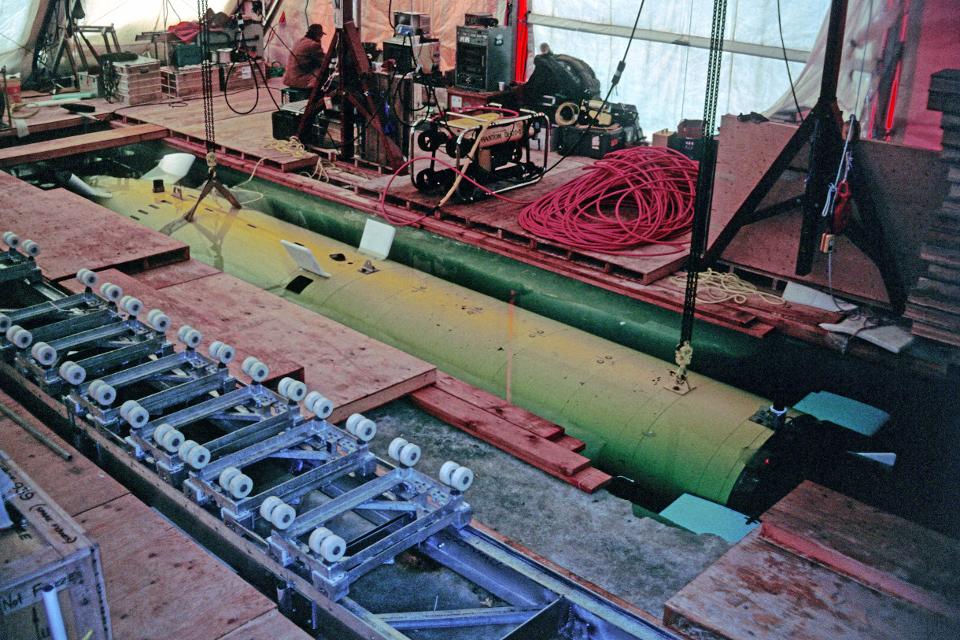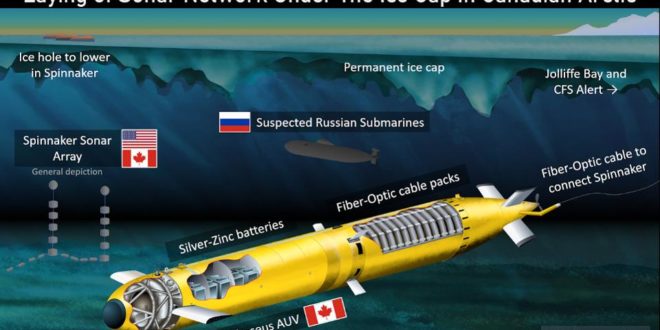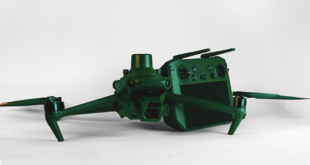Extra-large autonomous submarines may revolutionize intelligence gathering and espionage under the sea. One of these ground breaking projects is the U.S. Navy’s Boeing Orca extra-large uncrewed underwater vehicle (XLUUV). It is much larger than any other underwater drone currently in the water. But there is a historical precursor which, despite its epic Cold War story, is not widely known. And its mission, to lay covert sensor networks in the arctic, may be as relevant today as it was then.
The critical fiber-optic cable to connect the Canadian / US Spinnaker sonar array to CFS Alert was … [+]
During the Cold War NATO believed that Russian submarines were using the ice cap in the Canadian arctic as cover to covertly move between the Atlantic and Pacific. So the U.S. and Canada placed a special sonar network there, deep under the ice. Canadian engineers had to build the world’s largest autonomous underwater vehicle (AUV), Theseus, to lay a cable where ships could not reach.
The project started in the 1980s, at a time when Russian submarines were getting much quieter. To listen for them, a joint U.S. and Canadian sonar array was to be placed several hundred miles north of the remote Canadian base at CFS Alert. The array was codenamed Spinnaker, in honor of the bar where scientists made many of the unclassified decisions in the project. This was similar to the now-famous SOSUS (Sound Surveillance System), but used classified technology to match its operational circumstances. In fact it must have been much more advanced than the original SOSUS.
Connecting the sonar array to the base would require laying a fiber-optic cable for hundreds of miles under permanent ice cap. The solution was to build the world’s largest autonomous underwater vehicle. The uncrewed submarine would swim from an ice hole nearer to the base all the way to the Spinnaker array. As it went the cable would unreel out of the back. Thus ‘Theseus’ got its name from the mythical hero of Ancient Greece who trailed thread behind him when he ventured into the labyrinth to fight the Minotaur.
When we think of advanced Canadian military projects which were ahead of their time, the Avro Canada CF-105 Arrow springs to mind. That delta-winged Mach-2 fighter flew in the 1950s and was cutting edge technology at the time, one of the all-time great aircraft. But it was cancelled abruptly in 1959 before it could enter service. Theseus AUV is up there with the Avro Arrow, but less well recognized. And unlike the Arrow, it was used operationally, in one of the boldest projects started during the Cold War.
The project had many secret aspects. Years later much of what we know about the project comes from Bruce Butler, one of the core team involved. Bulter has written a book, Into the Labyrinth (on Amazon), and recently talked to the Underwater Technology Podcast about the project.
Theseus was 35 feet long and about 4 feet across. In AUV terms this is large, even today. In modern naval terminology it would be categorized as a large-displacement uncrewed underwater vehicle (LDUUV).

The Theseus AUV, an uncrewed submarine, sits ready to be lowered through an ice hole. The person … [+]
The Spinnaker sonar system was placed on the sea floor right on the edge of the arctic shelf. It was about 84 degrees north, up in the top right-hand corner of Canada, near to Greenland. Such an advanced project took years to realize, so it was not until spring 1996 when Theseus could go to work laying the cable. The whole operation was pushing the boundaries of uncrewed underwater vehicles at the time. Despite some close calls along the way, Theseus was able to navigate to the Spinnaker, letting out the vital thread as it went.
Many details of the project and technology involved are still classified. And we may never know whether Spinnaker ever picked up any Russian submarines. By the time it had been laid the Russian Navy was in steep decline following the end of the Cold War.
But with a resurgent Russian Navy today, the relevance of systems like Spinnaker may be greater than ever. And one of the roles which large submarine drones like the Orca might do is lay cables on the sea floor, unseen from above. Historical precedents like Theseaus can help us understand the way that these might be employed, and the challenges that they will face.
 Unmanned Aerial Vehicle The latest drone news
Unmanned Aerial Vehicle The latest drone news




